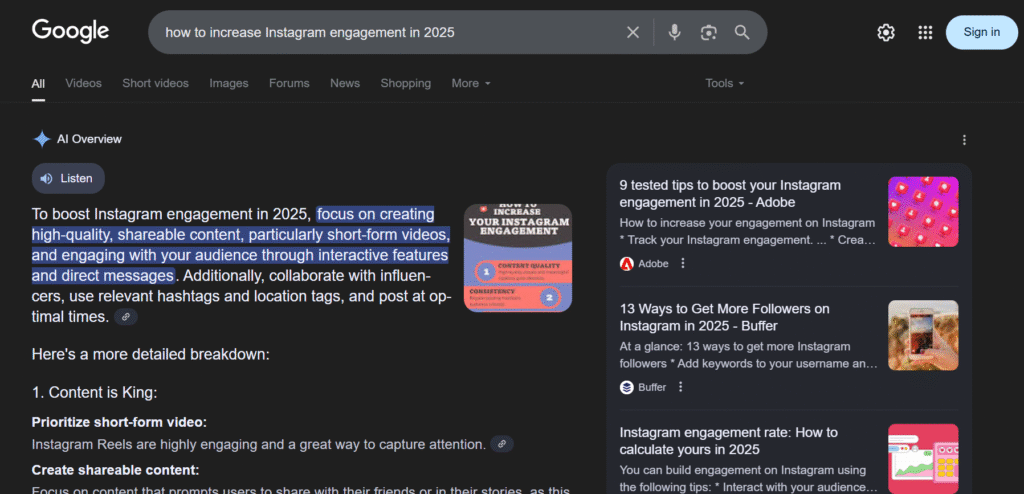In 2025, the world of SEO is undergoing a silent revolution. While most digital marketers are still optimizing keywords, fine-tuning meta tags, and publishing long-form content, a powerful and invisible change is sweeping across Google Search—and it’s breaking the way we track and understand web traffic.
We’re talking about AI Overviews, Google’s new search feature that delivers AI-generated answers right at the top of the page. And whether you’ve noticed it or not, it’s already affecting your website’s traffic in ways that traditional tools can’t detect.
Let’s break it down: what’s happening, why it matters, and what you need to do right now to stay ahead.
What Are AI Overviews?
Google’s AI Overviews (previously called Search Generative Experience or SGE) are designed to give users quick, synthesized answers drawn from multiple sources across the web. Instead of sifting through several links, a user can simply read the AI summary and walk away with their question answered—no click required.
While this may sound like a win for users, it presents a growing challenge for website owners and marketers. Google is essentially becoming the final destination, not just a bridge to your site.
Example: If someone searches “how to increase Instagram engagement in 2025,” they might get a summarized paragraph with tips, tools, and strategies—without ever clicking a blog post like yours.

The Real Problem: Invisible Traffic
Here’s the kicker. When users do click through from an AI Overview, that traffic often shows up in your analytics as “direct traffic”—meaning it has no referral source. In other words, your Google Analytics or Search Console won’t tell you that this visitor came from an AI-powered search result.
You might notice your organic traffic declining even though your rankings are steady. Or worse, your most valuable pages might be featured in AI Overviews but appear to underperform in analytics reports.
This has been reported by multiple digital marketing experts, including Loop Digital, who observed significant click-through rate (CTR) drops and unaccounted traffic spikes tied directly to the rollout of AI Overviews. Even Search Engine Land has highlighted the way AI Overviews are shifting the structure of search result pages, affecting both impressions and user behavior.
The Stats Are Worrying
Early data suggests:
- A 15-30% drop in organic CTR for top-ranking pages on AI-affected search queries.
- Up to 60% of informational traffic is now intercepted by AI-generated summaries.
- More than half the clicks on AI-generated content are untraceable in conventional analytics.
This means that even when your content is ranking and performing well, it may look like it’s underperforming—which can mess with reporting, strategy, and budgets.
Why You Should Care
For digital marketers, these changes aren’t just technical hiccups—they’re strategy killers. Here’s how it affects you:
- Content strategy blind spots: You don’t know which pieces are driving real results.
- Misguided budget allocation: Channels that appear to drop in performance might be working fine.
- Skewed attribution models: You may incorrectly credit or penalize parts of your funnel.
If you rely on data to inform decisions (and who doesn’t?), this is a serious problem.
So, What Can You Do?
You can’t stop Google from evolving. But you can adapt. Here’s how:
1. Focus on “Un-AI-able” Content
AI Overviews do a great job summarizing basic, factual information. But they struggle with:
- First-person stories
- Original research
- Case studies
- Thought leadership and opinions
- Deep, niche expertise
Example: Instead of writing “Top 10 SEO Tips for 2025,” try a case study like “How We Grew a SaaS Client’s Organic Traffic by 412% in 90 Days.” Google’s AI might still reference it—but users are more likely to click for the full story.
2. Build a Recognizable Brand
When users do glance at sources in an AI Overview, they’ll gravitate toward familiar or authoritative names. You want to be that name.
To get there:
- Be present on multiple platforms (YouTube, LinkedIn, podcasts)
- Guest post on respected sites
- Earn mentions and backlinks from trusted industry voices
This isn’t just SEO—it’s brand authority. And it’s more important than ever.
3. Improve Behavioral Tracking
If referral data is broken, you need new ways to understand your visitors.
- Use GA4 custom dimensions to tag user behavior
- Add scroll depth and click tracking
- Install tools like Hotjar or Microsoft Clarity to visualize what visitors are doing
Also consider using UTM parameters in internal links where possible to better trace where visitors come from.
4. Monitor the SERPs Manually
Set up alerts for your top-performing keywords and check if they now show AI Overviews. If your content appears in the summary, capture it. Screenshots and manual logs might become part of your regular SEO reporting now.
You can also use tools like SERPWatcher or SEMRush to monitor SERP changes dynamically. The SEMRush blog has even shared updated insights into how marketers can track lost visibility due to AI interruptions and adapt accordingly.
What’s Next?
Google isn’t going backward. AI Overviews are here to stay—and they’ll only get smarter.
Some predict that Google might soon provide metrics for AI Overview impressions and clicks inside Google Search Console. But until then, we need to work with uncertainty.
This is not the time to panic. It’s the time to get creative, think long-term, and stay deeply connected to your audience. The game is changing. But if you’re willing to evolve, there’s still plenty of opportunity.
Final Thoughts
At Real Rank Riser, we’re already helping clients navigate this new landscape. Whether it’s optimizing for visibility in AI Overviews or building strong brand authority that cuts through algorithmic noise, we’re focused on what really drives results—real impact, not just rankings.
The invisible shift is already underway. Don’t let your strategy become outdated before you even realize what’s changed.
If you need help adjusting your digital marketing approach to fit the AI-powered future, contact us today. Let’s rise above the noise—together.

